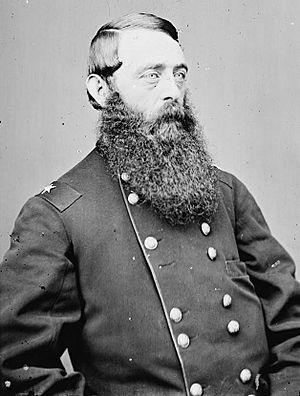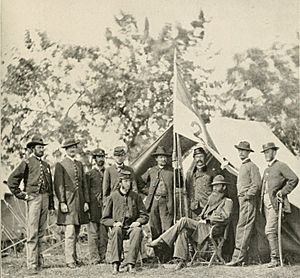David McMurtrie Gregg facts for kids
Quick facts for kids
David McMurtrie Gregg
|
|
|---|---|

General David McMurtrie Gregg
|
|
| Born | April 10, 1833 Huntingdon, Pennsylvania |
| Died | August 7, 1916 (aged 83) Reading, Pennsylvania |
| Place of burial |
Charles Evans Cemetery, Reading, Pennsylvania
|
| Allegiance | United States of America Union |
| Service/ |
United States Army Union Army |
| Years of service | 1855–1865 |
| Rank | |
| Battles/wars | American Civil War |
| Other work | U.S. Consul |
David McMurtrie Gregg (born April 10, 1833 – died August 7, 1916) was an American soldier and diplomat. He became a Union cavalry general during the American Civil War. After the war, he worked as a farmer and a U.S. Consul.
Contents
Becoming a Soldier
David McMurtrie Gregg was born in Huntingdon, Pennsylvania. He was related to important people in Pennsylvania. His first cousin, Andrew Curtin, later became the governor of Pennsylvania. His grandfather, Andrew Gregg, was a U.S. Congressman.
Gregg studied at the United States Military Academy (West Point). He graduated in 1855. After West Point, he became a second lieutenant in the 2nd U.S. Dragoons Regiment. This was a type of heavy cavalry. At West Point, he met two future cavalry generals. One was J.E.B. Stuart, who would fight against him. The other was Philip Sheridan, who would become his commander.
His first job was in the New Mexico Territory. He led a company in the 1st U.S. Dragoons. Later, his unit moved to California and then to Fort Vancouver in Washington Territory. During this time, Lt. Gregg fought his first battle. His 160 men faced 1,000 Native American warriors. The fight lasted three days. Gregg managed to lead his men to safety.
Fighting in the Civil War
When the Civil War began, Gregg returned to Washington, D.C.. He was promoted to captain in the 3rd U.S. Cavalry. Soon after, he moved to the 6th U.S. Cavalry. He became very sick with typhoid fever. He nearly died when the hospital he was in caught fire. In January 1862, he became a colonel and led the 8th Pennsylvania Cavalry.
Early Battles and Promotions
Gregg and his 8th Pennsylvania soldiers fought in the Peninsula Campaign. He did very well in the Seven Days Battles. He skillfully protected the retreating Union infantry. His next battle was Battle of Antietam, but cavalry did not play a big role there. After these battles, he took a break. He married Ellen F. Sheaff on October 6, 1862.
Gregg was promoted to brigadier general before the Battle of Fredericksburg. Like at Antietam, the cavalry was not used much. He commanded a brigade in the division of Alfred Pleasonton. Later, he took command of another cavalry brigade. Its leader, Brig. Gen. George Dashiell Bayard, was killed.
After Maj. Gen. Joseph Hooker took command of the Army of the Potomac, he changed how the cavalry was organized. He brought all the cavalry units together into one large Cavalry Corps. Maj. Gen. George Stoneman led this new corps. In February 1863, Gregg took command of the 3rd Division within this corps.
Cavalry Raids and Major Engagements
At the Battle of Chancellorsville, Stoneman's cavalry, including Gregg's division, went on a raid. They rode around General Lee's army to destroy things behind his lines. The raid lasted nine days and caused damage. However, it did not help much in the main battle. Stoneman was criticized for not being aggressive enough. Maj. Gen. Alfred Pleasonton then replaced Stoneman as the head of the Cavalry Corps.
The Battle of Brandy Station was the largest cavalry battle of the war. It happened at the start of the Gettysburg Campaign. Union forces wanted to find out where Lee's army was going. They launched a surprise attack on Maj. Gen. J.E.B. Stuart's cavalry. Gregg led his divisions across Kelly's Ford. They attacked the Confederates from the side and rear. The fighting was intense, with soldiers using sabers in hand-to-hand combat. The Confederates managed to push Gregg back. The battle was a draw, but it gave the Union important information about Lee's plans.
During the Battle of Gettysburg, Gregg's division arrived on July 2, 1863. They protected the right side and rear of the Union Army. On July 3, a big cavalry battle happened east of Gettysburg. This area is now called "East Cavalry Field." Stuart's forces fought against Gregg's division and Brig. Gen. George Armstrong Custer's brigade. There was a long mounted battle, with close-up fighting. Both sides claimed they won.
Later, in October 1863, General Lee tried to go around the Union army near Warrenton, Virginia. Gregg's division held Lee back until more Union soldiers arrived. Gregg was upset because he felt he wasn't given enough credit for this action. He asked for an official review to correct the record.

In early 1864, Gregg led the Cavalry Corps of the Army of the Potomac. This was until Maj. Gen. Philip Sheridan arrived. Sheridan then took command of all cavalry under Lt. Gen. Ulysses S. Grant. Gregg's cavalry was important for protecting Union movements. They also took part in a big raid that led to the Battle of Yellow Tavern. In this battle, J.E.B. Stuart was badly wounded and later died. This was a big loss for the Confederacy.
Gregg's division also fought hard at the Battle of Haw's Shop. They fought against Wade Hampton III's Confederate cavalry. Hampton had more soldiers, but Gregg's men had better rifles. Finally, Custer's brigade attacked and forced Hampton's men to retreat.
After the Battle of Trevilian Station, Sheridan's cavalry retreated. Gregg's division protected this retreat, especially at the Battle of Saint Mary's Church. Gregg's division survived a strong attack. However, they lost some prisoners.
Gregg stayed near Petersburg while Sheridan fought in the Shenandoah Valley. Gregg's cavalry protected Union movements during the Siege of Petersburg. His division fought in battles like the Second Battle of Deep Bottom and the Second Battle of Ream's Station. Near the end of his service, he was promoted to the honorary rank of major general.
Life After the War
Gregg resigned from the army before the war ended. He settled in Reading, Pennsylvania, his wife's hometown. He tried farming in Delaware, but he found civilian life boring. He later said he regretted leaving the army. In 1868, he tried to rejoin the army, but the cavalry job he wanted went to his cousin, John Irvin Gregg.
In 1874, President Grant appointed him U.S. Consul to Prague, which was then in Austria-Hungary. But he soon returned home because his wife missed America.
Gregg was active in his community. He helped raise money to protect Valley Forge as a national landmark. He visited the Gettysburg Battlefield many times and gave speeches. In 1891, he entered politics. He was elected Auditor General of Pennsylvania.
David McMurtrie Gregg died in Reading, Pennsylvania. He was one of the oldest Civil War survivors in the state. He is buried in Charles Evans Cemetery. There is a bronze statue of him on a horse in Reading. The local American Legion Post is named "Gregg Post" in his honor. The Gregg Cavalry Shaft at Gettysburg also honors the soldiers who fought there.
Images for kids
See also
- List of American Civil War generals (Union)




